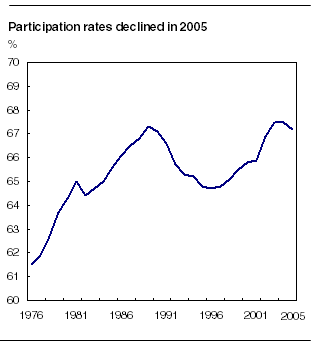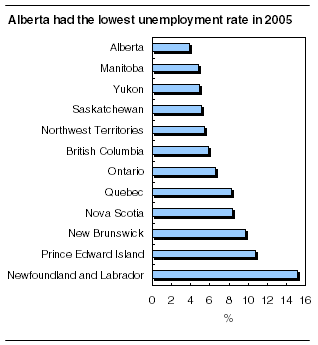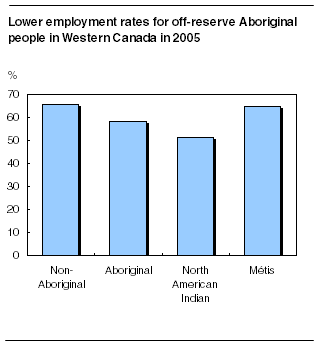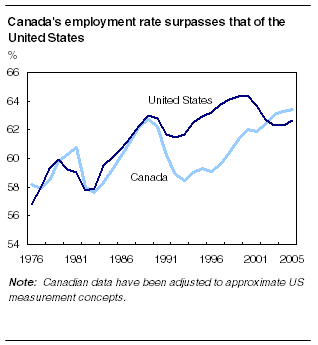
















 |
|
 |                |
Information identified as archived is provided for reference, research or recordkeeping purposes. It is not subject to the Government of Canada Web Standards and has not been altered or updated since it was archived. Please "contact us" to request a format other than those available.

|

Thursday, June 1, 2006 Study: Canada's labour market at a glance2005 Employment in Canada increased for a 13th consecutive year in 2005, the longest stretch of employment gains since the large-scale increases of the 1960s and 1970s. Over the last 13 years, employment growth has averaged 2.0% per year, according to a new report on Canada's labour market. Despite the fact that jobs were readily available last year, people took themselves out of the labour market, leading to a rapid tightening of labour market conditions. 
About 17.3 million people were in the labour market last year, 67.2% of the working-age population, a decline of 0.3 percentage points from 2004. Previously, the participation rate had increased every year between 1996 and 2003, and had held steady in 2004. Much of the decline in 2005 was the result of ageing baby boomers, adult women and young people leaving the labour force. With demand for labour strong and supply conditions tightening, the unemployment rate fell in 2005, hitting 6.8%, the lowest annual unemployment rate since 1976. The report also pointed to other key developments in the labour market during the past few years. For example, the employment situation for older workers aged 55 and over has become increasingly brighter. Last year, 29.9% of this population had jobs, up from 29.0% in 2004, the ninth consecutive annual increase in their employment rate since hitting a low of 22.0% in 1996. Some of these gains have been due to the influx of baby boomers into this group. At the same time, more workers are nearing retirement than ever before. In 2005, an estimated 3.6 million workers were within 10 years of (or older than) the median retirement age of 61. They represented 22.1% of the total, up from 10.3% in 1986. Provinces: Albertans continue to enjoy strongest labour marketOil-rich Alberta has consistently enjoyed the highest employment rates in Canada during the past three decades. The province's employment rate (the share of the population 15 and over who are employed) fell slightly in 2005, from the record high attained in 2004, to 69.8%, yet remained among the highest experienced by the province in nearly three decades. These high employment rates reflect the upward trend in job growth that began in the early 1990s. 
Alberta's employment growth slowed last year. However, since 1993, the province has averaged a healthy gain of 3.2% per year. Its average hourly wage grew by 6.6% in 2005, well above the 3.2% growth at the national level. However, the rapid increase in average hourly wages, the moderate employment growth and large shifts in employment among industries indicate that Alberta is starting to experience labour shortages. Another indicator of labour shortages is the extremely low unemployment rate in Alberta. In Western Canada, the employment rate in 2005 for Aboriginal people living off-reserve was 58.3%, much lower than that for non-Aboriginal people (65.5%). Employment rates for Aboriginal people in Western Canada varied from only 52.0% in Saskatchewan to 64.2% in Alberta. 
In British Columbia, the employment rate has hovered around 60.0% since 1989, avoiding the drop experienced by several other provinces during the early recession of the 1990s. In 2005, British Columbia's employment rate hit a record 61.8% as a result of a 3.3% gain in employment, the fastest growth rate among the provinces. However, people living in the Yukon and Northwest Territories were more likely to be working in 2005 than in any province. In the Yukon, 72.1% of the population aged 15 and over were employed in 2005, almost identical to the 72.3% in the Northwest Territories. Both rates were well above the national average of 62.7%. Since 1995, Calgary has consistently posted the highest employment rate of any major census metropolitan area. In 2005, 70.8% of all Calgarians aged 15 years and over had jobs, down slightly from 71.7% the year before. The decline occurred because its population grew twice as fast as employment. The employment rate in Edmonton has also been among the highest in the country. Employment in Canada's largest city, Toronto, grew by 2.1% last year, with the largest gains in trade, educational services and construction. The working-age population rose slightly faster than employment, so Toronto's employment rate edged down from 64.7% to 64.5%. International comparisons: Employment trends diverge between Canada and the United StatesFor the last three years, Canada's employment rate has remained at record levels, surpassing employment rates in the United States. 
Last year, 63.4% of the Canadian population 16 and over was employed (adjusted to compare with US labour statistics), compared with 62.7% of the American population. Between 2003 and 2005, employment rose 2.9% in the United States, but this was still slightly below the growth of 3.2% in Canada. Although Canada lost manufacturing jobs during this period, its employment growth was strong in many other sectors. This was the case particularly in construction, retail and wholesale trade, finance, insurance, real estate and leasing and educational services. Canada's unemployment rate, adjusted to the US definition of unemployment, has dropped in the last 12 years, from a high of 10.8% in 1993 to an all-time low of 6.0% last year. Meanwhile, the US unemployment rate fell from a high of 7.5% in 1992 to a low of 4.0% in 2000. Then it climbed to 6.0% in 2003, and by 2005, it was down to 5.1%. These recent changes in unemployment rates have narrowed the gap between the two countries. During the last four years, Canada's rate has been within one percentage point of the US rate. The last time the gap was so small was in 1982. Other areas: Self-employment, moonlighting, wagesThis report also examined other facets of employment in Canada, such as self-employment, moonlighting and wages. An estimated 2.5 million people were self-employed in Canada last year, representing 15.5% of all workers. Mostly because of a drop in main-job farm employment, self-employment levels fell in 2000 and 2001. However, growth in this area has rebounded since 2001, largely because of recent strength in construction and in real estate, sectors where self-employment is more common. In 2005, the number of self-employed rose 2.4%. Moonlighting — working at two or more jobs — is now more common among women than men. Last year, an estimated 848,000 Canadians were moonlighting, accounting for 5.2% of all workers. Since 1976, the number of women working at two or more jobs increased at a faster pace, and by 2005, 6.1% of employed women were moonlighting, compared with 4.5% of men. In terms of wages, Canadian employees last year earned on average $19.09 an hour before taxes and other deductions, 3.2% higher than the year before. This was slightly faster than the rate of inflation of 2.2% as measured by the Consumer Price Index (CPI). The average growth in hourly wages (current dollars) has exceeded the increase in the CPI for the past two years. As a result, real hourly wages, adjusted for inflation, rose 0.6% in 2004 and 1.0% in 2005. Available on CANSIM: (613-951-4243), Definitions, data sources and methods: survey number 3701. The study The Canadian Labour Market at a Glance, 2005 (71-222-XIE, free) is now available online from the Our products and services page of our website. For general information or to order data, contact Client Services (1-866-873-8788; 613-951-4090; labour@statcan.gc.ca). To enquire about the concepts, methods or data quality of this release, contact Danielle Zietsma (613-951-4243), Labour Statistics Division. |
|
|
|